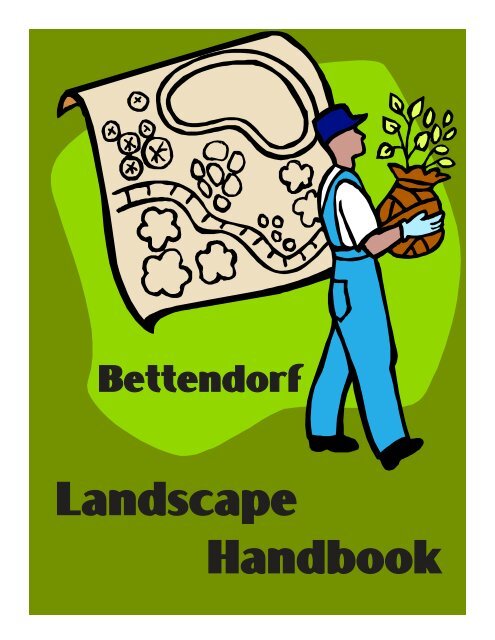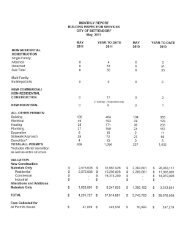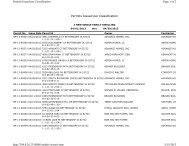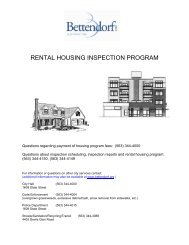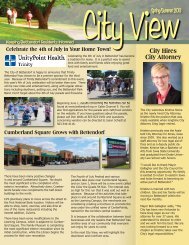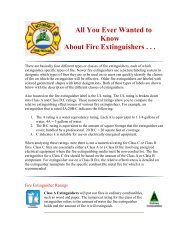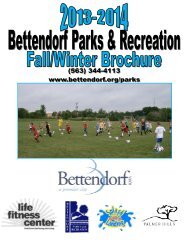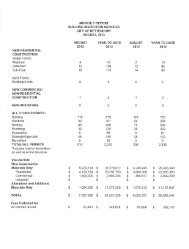Landscape Handbook - City of Bettendorf
Landscape Handbook - City of Bettendorf
Landscape Handbook - City of Bettendorf
You also want an ePaper? Increase the reach of your titles
YUMPU automatically turns print PDFs into web optimized ePapers that Google loves.
<strong>Bettendorf</strong><strong>Landscape</strong><strong>Handbook</strong>
<strong>City</strong> <strong>of</strong> <strong>Bettendorf</strong><strong>Handbook</strong> on Landscapingfor New DevelopmentPrepared by the Community Development DepartmentRevised September 2010
Table <strong>of</strong> ContentsIntroduction 1Applicability 1Submittal Guidelines 1Overview 2Landscaping along Street Rights-<strong>of</strong>-way 2Greenspace 2Table 1. Street Yard Greenspace 3Provision <strong>of</strong> Trees 3Diagram 1Example 3Diagram 2Buffer Yards 4Zoning 4Table 2. Buffer Yard Requirements 5Table 3. Required Buffer Yards 5Relationship 5Diagram 3 (a) Common Lot LinesDiagram 3 (b) Intervening AlleyDiagram 3 (c) Intervening Major StreetDiagram 3 (d) Intervening Local StreetScreening 6Vehicular Use Areas 7Greenspace 7Provision <strong>of</strong> Trees 7Front Yard 7Other Requirements 7Material Standards 7Tree Factor Conversion Table 8Prohibited Trees 9Tree Preservation 10Installation 10Vision Clearance 11Maintenance 11Modifications 11
INTRODUCTIONThe landscaping regulations are intended to improve the physical appearance <strong>of</strong> thecommunity; to improve the environmental performance <strong>of</strong> new development bycontributing to the abatement <strong>of</strong> heat, glare, and noise by promoting naturalpercolation <strong>of</strong> storm water and by improving the quality <strong>of</strong> air; to buffer potentiallyincompatible land uses from one another; and to preserve the value <strong>of</strong> property andneighborhoods within the city.By presenting these requirements and guidelines in a consistent manner, we can bettermeet our goals by minimizing subjectivity, retaining design flexibility, and expediting thereview process. It is hoped that the establishment <strong>of</strong> the landscaping requirements willencourage the ethic that landscaping, open space, and landscaping preservation areintegral parts <strong>of</strong> the development process.Questions or comments should be addressed to the Community DevelopmentDepartment at 4403 Devils Glen Road or by phone at (563) 344-4100.APPLICABILITYLandscaping is required on all new commercial, industrial, and multi-family residentialdevelopments. Additionally, landscaping is required for any addition to existingdevelopment which increases the building and/or parking area by 20 percent or more.In such cases, the requirements apply only to the portion <strong>of</strong> the lot where the newdevelopment occurs. The requirements do not apply to single-family and two-familyresidential developments. A common development that includes more than one lot orsite shall be treated as one lot or site for the purposes <strong>of</strong> satisfying the requirements <strong>of</strong>this section.SUBMITTAL GUIDELINESA landscape plan shall be submitted as part <strong>of</strong> the site development plan reviewprocess. If no site development plan review is required, a landscape plan shall besubmitted to the <strong>City</strong> Council for approval before any building permits are issued. TheCouncil may approve, approve with conditions, or deny the application. An applicantshould submit three copies <strong>of</strong> the landscape plan with the application.A landscape plan at a scale <strong>of</strong> 1 inch = 20 feet shall be prepared by a landscapearchitect, arborist, or other similar pr<strong>of</strong>essional and shall show graphically and labelclearly all items related to the project including, but not limited to, the following:1. Title, scale, north marker, and date.2. Zoning classification <strong>of</strong> site and adjoining property.3. Location and dimensions <strong>of</strong> all retaining walls, fences, walks, existing andproposed structures, overhead utilities, refuse disposal areas, electrical andmechanical equipment, and vehicular use areas.4. All lot lines, easements, and rights-<strong>of</strong>-way.5. All surrounding roads including names.1
6. The total square footage <strong>of</strong> the vehicular use areas.7. Any condition listed in the Screening section.8. Location, scientific name, common name, quantity, and size <strong>of</strong> all existing plantmaterials and designation <strong>of</strong> all vegetation to remain and/or be removed.9. Proposed landscape plantings by location, scientific name, common name,quantity, planting size, and planting method. A plant list should be providedlisting this information and keyed to plant locations on the plan.10. Plant installation details.11. Contours at 1-foot intervals <strong>of</strong> all proposed berms and the area within the dripline <strong>of</strong> all trees to be preserved.12. Drainage and detention areas.13. Any other feature as determined necessary by the Community DevelopmentDirector.14. Elevations, cross-sections, and other details as determined necessary by theCommunity Development Director.15. Designation <strong>of</strong> area to be used for snow storage.OVERVIEWThe city does not require landscaping in specific places on the site; rather, the ordinancedelineates certain general areas <strong>of</strong> the lot and requires a specific amount <strong>of</strong> greenspaceto be placed within that area. The intent is to allow flexibility and site specific designs.For example, seven percent <strong>of</strong> the interior area <strong>of</strong> large parking lots must be developedas greenspace. The greenspace necessary to meet the requirement can be locatedanywhere within the boundaries <strong>of</strong> the parking lot - including islands, planting strips,and corners. This flexibility allows for parking lots to be tailored to the site and the needs<strong>of</strong> the developer.The ordinance has four main landscape requirements:1. Minimum depth <strong>of</strong> greenspace along the street right-<strong>of</strong>-way.2. Minimum percentage <strong>of</strong> vehicular use areas to be greenspace.3. Buffering and screening <strong>of</strong> incompatible uses.4. Within these greenspace areas, the ordinance requires a certain number <strong>of</strong> treesto be planted and maintained.The following sections detail the guidelines for each general requirement.LANDSCAPING ALONG STREET RIGHTS-OF-WAYGreenspace. A contiguous greenspace area, hereafter referred to as a "Street YardGreenspace", is required along the street right-<strong>of</strong>-way. The depth <strong>of</strong> this Street YardGreenspace shall be no less than the "minimum depth" (M) as set forth in Table 1.The minimum depth is measured starting from each street right-<strong>of</strong>-way line andextending perpendicularly into the lot. (See Diagram 1.) The Street Yard Greenspace isdetermined by multiplying the minimum depth (M) by the width <strong>of</strong> the lot (W). Access2
drives generally perpendicular to the street right-<strong>of</strong>-way are the only permittedstructures within the minimum depth area.Table 1. Street Yard GreenspaceDistrictMinimum Depth(M)A-1 Agricultural 50 feetA-2 Rural Residence 40 feetR-1 Single-family Residence 30 feetR-2 Single-family Residence 25 feetR-3 Single-family and tw<strong>of</strong>amily25 feetResidenceR-4 Multi-family Residence 20 feetR-5 Multi-family Residence 20 feetC-1 Local Shopping 20 feetC-2 Community Shopping 15 feetC-3 General Business 15 feetC-4 Automotive Service 15 feetC-5 Office/Transitional 20 feetC-6 Office and Research Park 50 feetC-7 Public Gathering and15 feetRecreational ActivityI-1 Limited Industrial 45 feetI-2 General Industrial 20 feetI-3 Heavy Industrial 45 feetProvision <strong>of</strong> Trees. The city does not require a specific number <strong>of</strong> a specific size andtype <strong>of</strong> tree to be provided. Instead, the city requires that a certain number <strong>of</strong> "treefactors" be provided. Different sizes and types <strong>of</strong> trees are worth a various value <strong>of</strong>tree factor. Tree size and conversion rates are listed in the Material Standards section.The intent <strong>of</strong> using tree factors instead <strong>of</strong> a specific number <strong>of</strong> specific trees is to allowthe design flexibility.One tree factor shall be required for every 700 square feet <strong>of</strong> the Street YardGreenspace. A bonus <strong>of</strong> one percent <strong>of</strong> the tree factor shall be granted for every threepercent that the area <strong>of</strong> the street yard exceeds the minimum area acceptable (M x W).The tree factors used to meet this requirement shall be located within the greenspacearea.Example. For example, the landscaping that would be required along the right-<strong>of</strong>-wayfor a development is illustrated in Diagram 2.The property is zoned C-2. From Table 1 it can be determined that the requiredminimum depth <strong>of</strong> the greenspace area is 15 feet (M = 15 feet). The lot is 180 feet3
wide (W = 180 feet). Therefore, the minimum area <strong>of</strong> Street Yard Greenspace requiredis 180 feet x 15 feet (M x W) or 2,700 square feet.To determine the number <strong>of</strong> tree factors which must be included in this area, theStreet Yard Greenspace (2,700 square feet) is divided by 700 square feet. Therefore, 3.9tree factors must be provided.In this example, additional greenspace is provided, and the number <strong>of</strong> trees requiredmay be reduced. In order to meet the requirements for a reduction, the additionalgreenspace area must be contiguous with the required greenspace.In this example, the depth <strong>of</strong> the total greenspace is 20 feet. The total Street YardGreenspace is the depth (D) <strong>of</strong> 20 feet multiplied by the width (W) <strong>of</strong> 180 feet, whichequals 3,600 square feet, while the required Street Yard Greenspace is 2,700 squarefeet (M x W)(15 feet x 180 feet). Therefore, the bonus area <strong>of</strong> 900 square feet (3,600 -2,700) may be used to reduce the number <strong>of</strong> tree factors by 10 percent (900 ÷ 2,700= 30 percent) (30 percent ÷ 3 = 10 percent). Reducing the 3.9 tree factor by 10percent results in a 3.5 tree factor which the developer would be required to providein the Street Yard Greenspace. The Material Standards section lists the tree types andsizes which can be used to achieve this number.BUFFER YARDSA buffer yard is a landscaped area along lot lines provided to separate and partiallyobstruct the view <strong>of</strong> two adjacent land uses or properties from one another. Nostructures other than fences shall be allowed in a buffer yard.A buffer yard shall be required when a use is established in a more intense zoningdistrict which is adjacent to a less intense zoning district. The owner or developer <strong>of</strong>the property within the more intense district shall install and maintain a landscapedbuffer yard on said property as set forth in this section. Buffer yard requirements applyonly to those districts listed in Table 2.The width <strong>of</strong> the buffer yard is based upon the zoning <strong>of</strong> the districts, the relationship<strong>of</strong> the districts, and the amount <strong>of</strong> screening provided.Zoning. The basic buffer yard width requirements are set forth in Table 2. When thedevelopment is adjacent to property zoned A-1 and likely to be developed, the Land UsePlan can be used as a guide to determine the future zoning and buffer yardrequirements in anticipation <strong>of</strong> that future use.4
4. Screening in Buffer Yards. The amount <strong>of</strong> screening in the buffer yard mayreduce the required width. (See Screening section for details.)SCREENINGScreening is required on all properties requiring a buffer yard when one or more <strong>of</strong>the following conditions in the more intense zoning district is directly visible from theboundary <strong>of</strong> the less intense zoning district:1. Outdoor storage areas.2. Loading/unloading areas, refuse collection points, and other service areas.3. Major machinery or areas housing a manufacturing process.4. Vehicular use areas.5. Sources <strong>of</strong> glare, noise, or other environmental effects.6. On- and above-grade electrical and mechanical equipment, including but notlimited to, transformers, heat pumps, and air conditioners.7. Satellite dishes.8. Other noxious uses as determined by the Community Development Director.Any screening material required by this ordinance shall be an opaque barrier at least 6feet in height in all yards except the front yard which shall be between 2 ½ feet and 3feet in height measured relative to the street grade. The design <strong>of</strong> the screen shall besuch as to completely obscure the view <strong>of</strong> the noxious use from the neighboringproperty. The following are acceptable barriers:1. A solid wood and/or masonry fence or wall <strong>of</strong> a design approved by theCommunity Development Director.2. A hedge or random, informal screen <strong>of</strong> conifer (evergreen) plant materialattaining the required minimum height within 3 years <strong>of</strong> planting. The initialheight <strong>of</strong> plantings shall not be less than one-half the required minimum height.3. A landscaped earth berm with a maximum slope <strong>of</strong> 3:1, rising no less than therequired minimum height above the existing grade <strong>of</strong> the lot line separating thezoning districts.4. Any combination <strong>of</strong> these methods that achieves a cumulative height no lessthan the required minimum height.One tree factor shall be planted and maintained for each 700 square feet <strong>of</strong> the bufferyard. The required tree factors shall be located within the buffer yard. Tree size andconversion rates are listed in the Material Standards section. The width <strong>of</strong> the bufferyard based upon the zoning and the relationship <strong>of</strong> the properties assumes that n<strong>of</strong>urther landscaping occurs. If additional screening is installed, the width <strong>of</strong> the bufferyard may be further modified as follows:1. When 50 percent opacity <strong>of</strong> the standards established the Screening section isachieved, only two-thirds <strong>of</strong> the required buffer yard must be provided.2. Only one-half <strong>of</strong> the required buffer yard must be provided if the buffer yardincludes screening meeting the standards established in the Screening section.6
Screening shall be installed no closer to the less intense district than one-half the width<strong>of</strong> the required buffer yard. Screening shall not adversely affect surface water drainage.VEHICULAR USE AREASVehicular use areas are all areas subject to vehicular traffic including accessways,driveways, loading areas, service areas, and parking stalls for all types <strong>of</strong> vehicles.Covered parking areas and underground parking structures are not included in thisdefinition. Landscaping for those types <strong>of</strong> facilities will be determined on a case-by-casebasis. Vehicular use areas less than 4,000 square feet in size shall be exempt frominterior landscaping requirements.Greenspace. Landscaping must be provided within the boundaries <strong>of</strong> the vehicular useareas such as islands, planting strips, and corners. The amount <strong>of</strong> landscaping requiredvaries with the area <strong>of</strong> the vehicular use area.For vehicular use areas greater than 4,000 square feet but less than 30,000 square feet,an area equivalent to a minimum <strong>of</strong> 5 percent <strong>of</strong> the total vehicular use area shall belandscaped. The required landscaped area shall be located in the interior <strong>of</strong> thevehicular use area.For vehicular use areas greater than 30,000 feet, an area equivalent to a minimum <strong>of</strong> 7percent <strong>of</strong> the total vehicular use area shall be landscaped. The required landscapedarea shall be located in the interior <strong>of</strong> the vehicular use area.Provision <strong>of</strong> Trees. One tree factor shall be required for every 500 square feet <strong>of</strong>required greenspace within the interior <strong>of</strong> vehicular use areas. Tree size andconversion rates are listed in the Material Standards section.Front Yard. Vehicular use areas, including parking, shall be allowed in the front yard<strong>of</strong> properties conforming to the requirements <strong>of</strong> these landscape regulations.However, the minimum depth requirement <strong>of</strong> landscaping shall be strictly enforced.If any vehicular use area other than a driveway is located within the required frontyard, screening shall be provided between said vehicular use area and the frontproperty line.Other Requirements. There shall be sufficient barriers to protect all landscaped areasfrom vehicular damage.The vehicular use area must terminate at least five feet from any exterior building wall.Exceptions may be made where it is necessary to cross the non-vehicular use area togain access to the buildings and for drive-up facilities such as banks and restaurants.MATERIAL STANDARDSThe following definitions will be used for plant material types.7
Deciduous Overstory Tree. A shade-producing woody plant having a mature heightand spread <strong>of</strong> at least 30 feet with one well-defined trunk and having no branches ator near the base. For a list <strong>of</strong> trees that are considered overstory trees, see Iowa StateExtension Office website for hardwood tree listings.Deciduous Understory Tree. A woody plant at least 10 feet tall at maturity with one ormore well-defined trunks.Deciduous Shrubs. Woody plants that range from 3 to 10 feet tall at maturity and<strong>of</strong>ten are multi-stemmed with low branching.EvergreenlConifer Tree. An upright cone-bearing plant having green needle-likefoliage throughout the year and at least 20 feet tall at maturity.Evergreen/Conifers Shrub. A woody plant having green needle-like foliagethroughout the year and ranging from 3 to 10 feet tall at maturity and <strong>of</strong>ten are multistemmedwith low branching.Required plant material shall meet the following minimum size specifications at thetime <strong>of</strong> installation. Additionally, the table indicates the number <strong>of</strong> plants by type andsize necessary to equal one tree factor credited towards fulfilling the tree requirement.Type and Size <strong>of</strong> TreeNumber <strong>of</strong> Tree FactorsDeciduous overstory2-inch caliper and 22-inch ball or pot 1.04-inch caliper and 40-inch ball or pot 2.0One-stem deciduous understory1 ½ -inch caliper and 16-inch ball or pot 0.53-inch caliper and 30-inch ball or pot 1.0Multi-stem deciduous understory6-foot height and 16-inch ball or pot 0.512-inch height and 30-inch ball or pot 1.0Evergreen6-foot height and 16-inch ball or pot 0.512-foot height and 30-inch ball or pot 1.0Deciduous or Evergreen Shrub5 gallon 0.0Ground Covers1 gallon 0.0Note: Preservation <strong>of</strong> existing trees counts as double the tree factor credit. See TreePreservation section and <strong>City</strong> tree ordinance regarding preservation <strong>of</strong> existing trees.8
For bare root plant material, the root spread should be as large as the specified diameter<strong>of</strong> the ball or pot.All new vegetation shall have an area equivalent to two-thirds <strong>of</strong> the area defined bythe drip line at maturity to allow for normal growth. All existing vegetation shall havean area equivalent to three-fourths <strong>of</strong> the area defined by the mature drip line. Sufficientspacing between other vegetation, buildings, pavement, and utilities shall be provided.All fences, walls, and other barriers shall be maintained in good repair, meaningstructurally sound and attractive in appearance. The finished face <strong>of</strong> all such barriersshall face outward toward the neighboring site or street.The following types <strong>of</strong> vegetation are not considered suitable for an urban settingbecause they are weak wood trees and/or associated with disease or pests. Thefollowing shall be prohibited except under special circumstances and with the approval<strong>of</strong> the Community Development Director.Common Name*Poplar and related speciesBox ElderSiberian ElmAmerican Elm*WillowTree <strong>of</strong> HeavenMulberry (female)European Mountain AshPin Oak*Silver Maple*European BirchGinkgo (female)Scientific NamePopulus speciesAcer negundoUlmus pumilaUlmus americanaSalix speciesAilanthus altissimaMorus albaSorbus aucupariaQuercus palustrisAcer saccharinumBetula papryiferaGingko biloba*Acceptable in designated flood plains.In addition to the above requirements, any required tree located within a vehicular usearea shall be a deciduous shade tree and meet the following requirements:1. At time <strong>of</strong> installation, the tree shall have a trunk caliper (diameter) <strong>of</strong> 2 inchesmeasured 6 inches above the ground.2. Because <strong>of</strong> shallow surface roots, fruit droppings, and/or low branches, the use<strong>of</strong> the following trees shall be prohibited in parking lots.Common NameAlderCatalpaNorway MapleScientific NameAlnus speciesCatalpa speciosaAcer plantinoides9
3. Trees producing berries shall require the approval <strong>of</strong> the CommunityDevelopment Director if located within the vehicular use area.TREE PRESERVATIONExisting trees approved by the Community Development Director for preservation shallbe counted toward satisfaction <strong>of</strong> the requirement for provision <strong>of</strong> trees. Preservation <strong>of</strong>each healthy existing tree <strong>of</strong> an approved species shall count as double the tree factorcredit. Additional credit can be counted toward the tree requirement for thepreservation <strong>of</strong> exceptional trees as determined by the Community DevelopmentDirector.It is usually cheaper and easier to save trees than to replace them. If possible, alandscape architect, forester, nurseryman, horticulturist, arborist, or other tree expertshould be asked to identify the kinds <strong>of</strong> tree and judge their condition and suitability forsaving.The key to saving trees is to protect the roots.. There is as much tree underground asabove ground. The underground roots are much more delicate than the trunk,branches, or leaves. Since they can't be seen, they are <strong>of</strong>ten hurt. Root damage canslowly kill a tree without leaving an obvious mark. The roots within the drip line arecritical. If this area is protected, the tree is not likely to be damaged by constructionequipment. Keep construction activities outside <strong>of</strong> the drip line <strong>of</strong> trees to be saved.Fences shall be constructed 5 feet outside <strong>of</strong> the drip line <strong>of</strong> all trees to be preserved.No grading, filling, or other construction activity shall occur within the fence. Be sure allworkers and visitors to the site understand that no one is to enter the fenced areas forany reason. Remove the protective fences only after all construction has been finishedincluding final grading and smoothing <strong>of</strong> the site.Changes in grade, cutting banks next to trees, or piling dirt close to them is almostalways damaging to a tree. Although the deep roots that attach the tree to the groundmay not be affected, the fine feeder roots, which are in the top 1 to 2 feet <strong>of</strong> soil, arevery sensitive to changes in their environment. Cutting soil away from a tree changesthe moisture level, and filling may suffocate the feeder roots. In all cases where eithercutting or filling around the roots <strong>of</strong> a tree is considered, seek expert advice beforedeciding which trees to keep.INSTALLATIONAll required landscaping shall be installed prior to occupancy or commencement <strong>of</strong> ause. On trees and shrubs, about one-third <strong>of</strong> the crown mass should be pruned out atthe time <strong>of</strong> planting which will give the roots a chance to strengthen themselves. Pruneout major branches by cutting as close to the branch collar as possible. Remove allbroken, dead, diseased, and overlapping branches, but try to retain the natural shape <strong>of</strong>the plant. Never remove the central leader <strong>of</strong> a tree. Wrap tree trunks in tree crepe toprotect against wind and sunburn. Water and fertilize all newly-installed plantsaccording to the directions <strong>of</strong> the nursery. Occasionally, protection is required for newly-10
installed plants in the form <strong>of</strong> barrier fences, staking for support, or warning signs.These items are specific to each individual project.If the landscaping cannot be installed prior to occupancy or commencement <strong>of</strong> a usebecause <strong>of</strong> climatic conditions, the Building Inspector may issue a temporary certificate<strong>of</strong> occupancy and grant a delay <strong>of</strong> landscaping installation until the calendar date <strong>of</strong>June 1 immediately following the date <strong>of</strong> said temporary certificate <strong>of</strong> occupancy.However, in such case, the applicant will be required to post a surety or cash bondequal to 150% <strong>of</strong> the total cost <strong>of</strong> the landscaping. No final certificate <strong>of</strong> occupancyshall be issued until the landscaping is installed as approved.VISION CLEARANCENo structures or plant materials shall obstruct a clear path <strong>of</strong> a motor vehicles driver'svision <strong>of</strong> approaching vehicles. An unobstructed vision clearance shall be maintained atall street intersections, private driveway and street intersections, and alley and streetintersections. On corner lots, the clear vision area will be a triangular area determinedby a diagonal line connecting two points measured 35 feet equidistant from the streetcorner. See Zoning Ordinance Section 18.29. Vision Clearance Triangle.MAINTENANCEUpon installation or preservation <strong>of</strong> required landscape materials, appropriate measuresshall be taken to ensure their continued health and maintenance including but notlimited to removal <strong>of</strong> litter, pruning, mowing, adequate watering, and weeding. Eachplant requires different types and frequency <strong>of</strong> care. Plants in stressful situations mayrequire more care and more frequent inspections. A local expert should be consulted todetermine the necessary maintenance. Required materials that do not remain healthyshall be replaced in a manner consistent with the approved landscape plan.Topping is the severe cutting back <strong>of</strong> limbs to stubs within the tree’s crown to such adegree so as to remove the normal canopy and disfigure the tree. Topping <strong>of</strong> requiredtrees is not allowed. Topping may be practiced on trees severely damaged by stormsonly if other pruning measures are impractical.Tree canopies over pedestrian and vehicular areas shall be pruned and maintained sothere is 8 feet <strong>of</strong> clearance above the pavement. If trucks use the vehicular use areathen 15 feet <strong>of</strong> clearance should be maintained.MODIFICATIONSThe landscaping shall be installed and maintained according to the approved landscapeplan except where authorized changes are permitted. The approved landscape planand supporting data shall be binding on the applicants, their successors, grantees, andassigns.A change in the approved site development plan or landscape plan which alters thelandscape requirements or the concept or intent <strong>of</strong> the landscape design including, but11
not limited to, a change in the vehicle use area, type <strong>of</strong> screening, and general location,size, or type <strong>of</strong> landscape materials, shall be approved only by submission <strong>of</strong> a newlandscape plan in accordance with the procedures previously set forth for the approval<strong>of</strong> site development plans.The city planner may approve minor changes in the landscape plan which do notchange the concept or intent <strong>of</strong> the development.All approved landscape plans superseded by an approved revised landscape plan shallbe considered to be null and void at the time <strong>of</strong> approval <strong>of</strong> the revised plan.12


